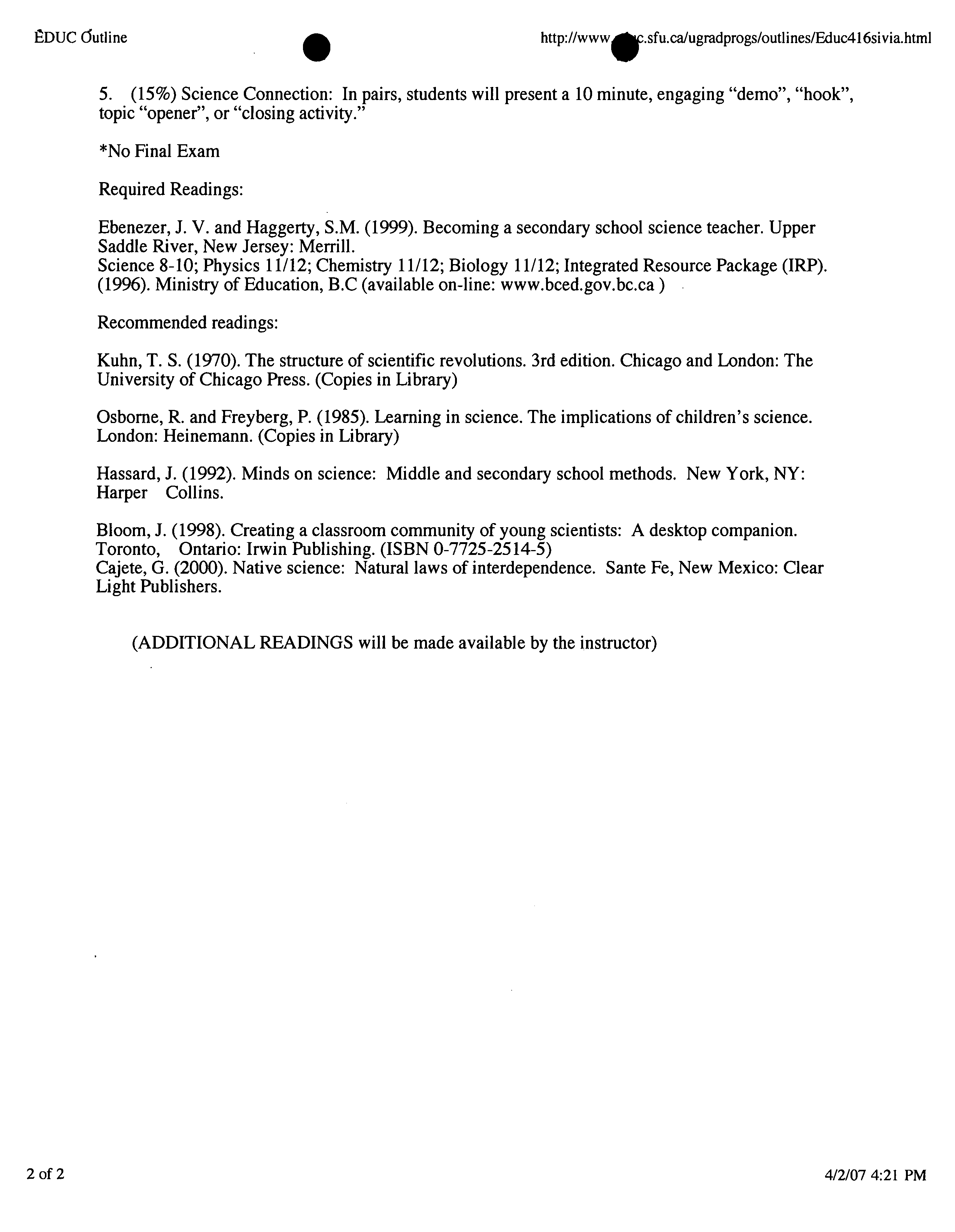EDUC Ciutline
W.sfu.ca/ugradprogs/outlines/Educ4l6sivia.htmI
SIMON FRASER UNIVERSITY?
SUMMER SEMESTER 2007
EDUC 416-4
DESIGNS FOR LEARNING: SECONDARY SCIENCE
?
(E01.00)
AWNEET SI VIA
email: asivia@sfu.ca
WEDNESDAY 5:30-9:20 EDB 7500B
PREREQUISITE:
EDUC
401/402
DESCRIPTION
Course Description: This course is designed for prospective and practicing secondary teachers who
wish to explore the fundamentals of teaching/learning as they apply to science. The course will draw
from literature about Science education and students will be expected to apply theoretical frames to
classroom practice. Students are expected to be familiar with a variety of teaching strategies, including
group work. Students will engage in conversations and write about curriculum development issues
arising from research traditions such as constructivism, feminism and critical pedagogy. Students will
draw upon their passion for Science as a starting point for developing lessons and activities to inspire
learning in their classrooms.
Topics: nature of science, science curriculum, interdisciplinary science, misconceptions,
teaching/learning strategies in science, assessment approaches, critical thinking, story and metaphors in
science, First Nations and culturally sensitive science, models of teaching and learning, representations
vs. reproduction in science, science literacy and special education.
Objectives: On completion of this course, it is hoped that students will feel more at ease with teaching
students Science at the secondary level, be able to deal confidently with prescribed curriculum, and be
able to plan teaching and learning activities which support a growth in Science understanding. Students
will analyze how to create and nurture a scientific community in their classrooms, with an aim to be
lifelong innovators in science education.
*Assignments:
1.
(15%) Critical Challenge OR Conceptual Representation: You will design a lesson that fosters
critical thinking using a specific framework OR you will design a 3D conceptual representation of a
scientific concept from the science 8-12 curriculum.
2.
(25%)
Curriculum Project: This project is an opportunity to design a series of about five - seven
lessons on a unit of your choice if you have completed 401/2. 405 students will redesign one or more
units taught in 405, design a series of assessments for a given course, or other options to be discussed
on the first day of the course.
3. (25%)
Group lesson and Self-analysis: Working in a group of 2-3 , students prepare a lesson on a
topic on the science curriculum. After teaching group lesson, students individually write a response to
feedback received from peers and the instructors.
4.
(20%) Inquiry or Reflective Paper/Poster: The goal of this task is to explore an area of further
development in teaching and learning science and/or an area that students want to learn more about but
which is previously not addressed by other assignments and activities. Examples might range from
examining practicum experiences to exploring science within multicultural settings.
lof2 ?
4/2/074:21 PM
IDUC Outline ?
http://www.sfu.caJugradprogs/out1ines/Educ416sivia.htm1
5.
(15%) Science Connection: In pairs, students will present a 10 minute, engaging "demo", "hook",
topic "opener", or "closing activity."
*No Final Exam
Required Readings:
Ebenezer, J. V. and Haggerty, S.M. (1999). Becoming a secondary school science teacher. Upper
Saddle River, New Jersey: Merrill.
Science 8-10; Physics 11/12; Chemistry 11/12; Biology 11/12; Integrated Resource Package (IRP).
(1996). Ministry of Education, B.0 (available on-line: www.bced.gov.bc.ca )
Recommended readings:
Kuhn, T. S. (1970). The structure of scientific revolutions. 3rd edition. Chicago and London: The
University of Chicago Press. (Copies in Library)
Osborne, R. and Freyberg, P.
(1985).
Learning in science. The implications of children's science.
London: Heinemann. (Copies in Library)
Hassard, J. (1992). Minds on science: Middle and secondary school methods. New York, NY:
Harper Collins.
Bloom, J. (1998). Creating a classroom community of young scientists: A desktop companion.
Toronto, Ontario: Irwin Publishing. (ISBN
0-7725-2514-5)
Cajete, G. (2000). Native science: Natural laws of interdependence. Sante Fe, New Mexico: Clear
Light Publishers.
(ADDITIONAL READINGS will be made available by the instructor)
2 of 2 ?
4/2/07 4:21 PM


